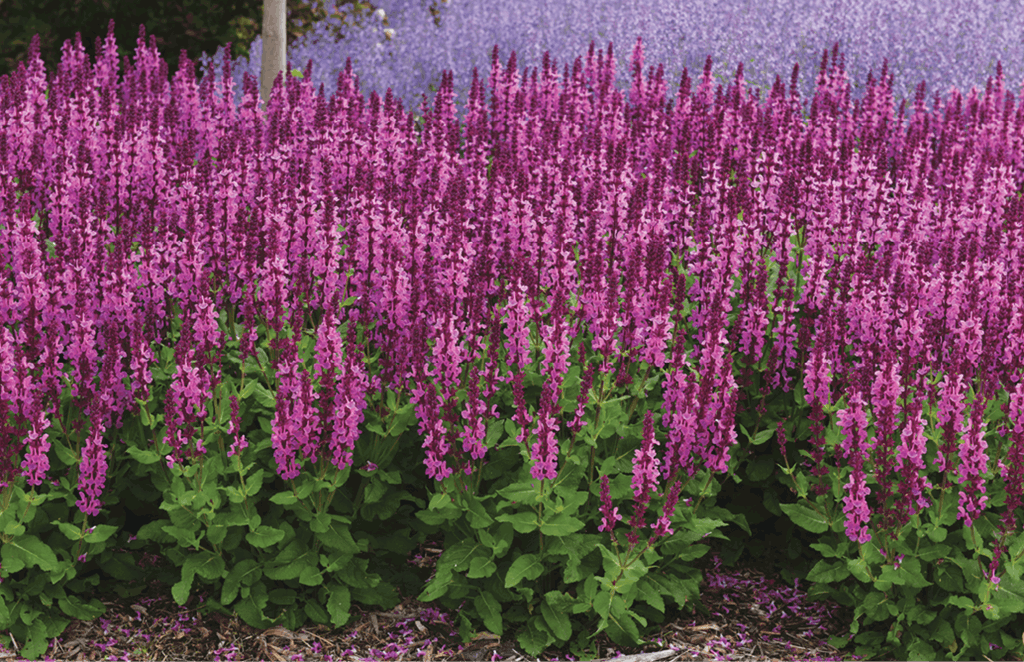
Best Overall Performance
Southeast
Agastache Poquito ‘Butter Yellow,’ Terra Nova Nurseries, The University of Georgia
Just hearing the word “butter” puts me in a good mood. Seeing the large butter yellow flower spikes on this Agastache from Terra Nova does the trick too. All season I have enjoyed the brightness and wispy habit of this smaller selection from the Poquito series.
Heuchera 'Forever Red,’ Terra Nova Nurseries, North Carolina State University
Wow, what a winner! The intense red foliage makes you stop and notice this beauty. Foliage is a brighter, more intense red in the spring when there is cooler weather. Plants are uniform mounds of fiery-red ruffled leaves with white flowers. Did well in our heat and humidity. This is year two out in full sun and it continues to impress.
Midwest
Salvia nemorosa Rose Marvel, Darwin Perennials, The Gardens at Ball
Salvia nemorosa Rose Marvel from Darwin Perennials was planted in our front garden beds and provided vibrant color for many weeks.
Digitalis Pink Panther, American Takii, Raker-Roberta’s Trial Gardens
We had the opportunity to trial this over the last few years and even early on, it was a solid performer. This year in our gardens, it continuously reflushed, looked great and was very well received by our visitors.
Dianthus Constant Beauty Crush, Green Fuse Botanicals, Mast Young Plants
All new bicolor introductions into the Constant Beauty family. Daylength neutral, continuously blooming, even under the hottest conditions. Hardy to zone 4.

Spigelia 'Little Redhead,’ Walters Gardens
Spigelia is native to the eastern United States and is a versatile perennial that does well in sun or shade. The gorgeous, tubular red flowers are a hummingbird magnet, and are produced beginning in late spring, continuing to bloom through mid-summer. 'Little Redhead' is a superior selection of the species, vegetatively propagated to ensure uniformity.
Kniphofia Gold Rush, Walters Gardens, Boerner Botanical Gardens
I have never seen a first-year perennial bloom like this, much less a Kniphofia. I really, really hope it survives our winter. I cannot imagine what it will look like in year two.
Northwest
Spigelia ‘Little Redhead,’ Walters Gardens, Smith Gardens
We grew these adorable plants in container trials and have since planted them into our landscape display to assess overwintering performance. They have a well-behaved upright habit, are easy to grow with no major pests or diseases, and sport tubular bicolor red/yellow flowers held on curving cymes (like Crocosmia).

Best Pollinator-Friendly
Southeast
Caryopteris ‘Gold Crest,’ Darwin Perennials, University of Georgia
‘Gold Crest’ is an excellent small to medium perennial with bright golden foliage that remained true all summer with clusters of blue flowers. This Caryopteris was covered with bees at all times and most importantly covered late in the season to extend its overall usage by pollinators, especially honeybees.
Echinacea Kismet Series, Terra Nova Nurseries, North Carolina State University
Continuous flowering on sturdy upright stems are good for cuts or you can leave the seed heads for the birds. Low maintenance, attractive flower colors and being easy to grow make them a gardener's favorite!
Midwest
Echinacea Cheyenne Spirit, PanAmerican Seed, The Gardens at Ball
Echinacea Cheyenne Spirit from PanAmerican Seed is a classic now, and its attractiveness for bees, butterflies and birds was amazing. We had a large planting outside our cafe windows and it was a joy to watch the season progress with new pollinators every few weeks.
Agastache BeeLicious, Concept Plants, Raker-Roberta’s Trial Gardens
Lots of flowers all season and lots of pollinators.
Agastache Poquito Butter Yellow, Terra Nova Nurseries, Penn State University
This excellent performer was consistently inundated with pollinators including butterflies and many species of Hymenoptera. While it is only the first year of three in the perennial trials, it grew well and bloomed all season.
Verbena Cloud, Proven Winners, Mast Young Plants
New standalone series. MYP Annual Comparison Trial Winner features lollipops of lilac blooms on deep green foliage A fun plant for landscapes and containers.
Allium 'Serendipity,’ Walters Gardens
This brand new perennial ornamental onion is a sport of Allium 'Millenium' that has all of the great qualities of the parent, but with blue foliage. The globe shaped rosy-purple flowers are produced prolifically in mid to late summer, unlike bulb Alliums, which typically bloom in spring and go dormant in the summer. The aromatic foliage deters deer and rabbits from feeding, and bees will collect both pollen and nectar from the flowers. Allium 'Serendipity' is part of the Proven Winners perennial program.

Northwest
Allium ‘Millenium’ and Allium ‘Serendipity,’ Walters Gardens, Smith Gardens
Allium Serendipity is a sport of Millenium and we trialed both varieties in pots this year. Masses of bees swarmed the flower clusters of both varieties in summer, making them a great pollinator-friendly perennial choice.
Best Heat-Tolerant
Southeast
Gaura ‘Cool Breeze,’ Jelitto Perennial Seeds, University of Georgia
This very impressive gaura from Jelitto Perennial Seed had two heavy blooms this year and stood up to the heat like a champ. ‘Cool Breeze’ has solid green leaves with large pure white flowers. It’s not uncommon to see pink or red in the fading flowers of gaura but this selection stayed pure white from beginning to end and we loved it.

Lychnis 'Petit Henri,’ Must Have Perennials, North Carolina State University
Uniform, compact plants with oblong, dark green leaves adorned with lots of clusters of double, white flowers. Blooms for a long time. Use for cuts.
Midwest
Sedum rupestre Prima Angelina, Darwin Perennials, The Gardens at Ball
Sedum rupestre Prima Angelina offered by Darwin Perennials held its bright chartreuse color through the season without burning. It remains a great-looking groundcover in our perennial beds, and was low-growing and fast-spreading in the summer months.

Rudbeckia American Gold Rush, Intrinsic Perennial Gardens, Penn State University
This plant has done very well in the PSU Flower Trials. The plants are in their second year of the three-year in-ground trials and have done very well in 2018 and 2019. In both seasons very little foliar spotting due to fungi has been observed. Plants received a 5.0/5.0 score for flowering in the second and third ratings in 2019.
Hibiscus Summerific 'Holy Grail,’ Proven Winners, Walters Gardens
This variety is the 'Holy Grail' of hibiscus breeding, with its dark, near-black foliage and 8-9-inch deep red flowers. This hardy hibiscus brings a tropical look to the garden but is hardy to Zone 4, but also thrives in the heat of summer! The rounded, polished habit and lime green calyxes make this plant even more desirable in the landscape. Hibiscus Summerific 'Holy Grail' is part of the Proven Winners perennial program.
Northwest
Lavandula stoechas Violeta Purple XL, Syngenta/ThinkPlants, Smith Gardens
Violeta Purple XL was the winner of Spanish Lavenders for us this year – when all of the others were done blooming, this one kept on going all summer. They’re pictured here in August, flowering with huge colorful flags atop strong upright stems. A real standout.
To see all of the plants, visit our sister publication, Greenhouse Management Magazine here.

Explore the April 2020 Issue
Check out more from this issue and find you next story to read.
Latest from Lawn & Landscape
- Landscape Workshop acquires Cut Above Enterprises
- Scythe debuts new generation of M.52
- New identities
- Ruppert promotes Anderson to director of talent acquisition
- Fleet on the Street
- Man in the mirror
- EverSmith Brands appoints Ken Hutcheson as its new CEO
- Manitou unveils new Woodcracker tree saw with grapple





